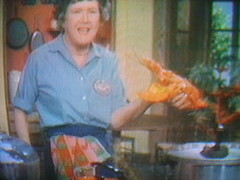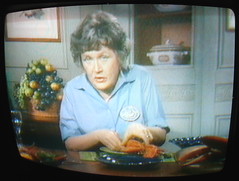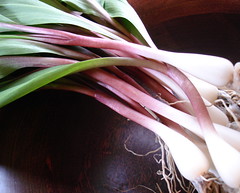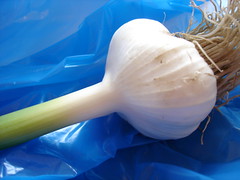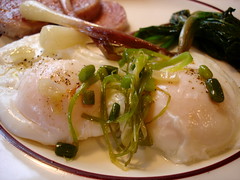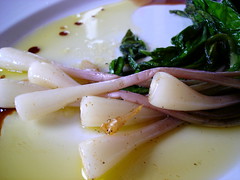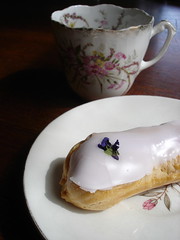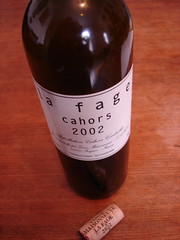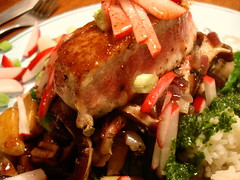Things got started on a Wednesday. That was the day my birthday gift from my sister showed up on our doorstep. I cracked open the package and found my very own copy of Anya von Bremzen's critically acclaimed The New Spanish Table. Karina had received a copy herself as a birthday gift late last year and she'd been raving ever since. She even brought it with her when she came to visit for Christmas, but our minds were on other matters and we never got around to testing it out.
I'm not sure if I'd talked with Karina about my current obsession with Spanish food over the phone or something. All I know is that the book was well chosen. Among other things, I'd spent weeks thinking about these Basque-style stuffed peppers that my friend Estibaliz had made for a group of us once in Bonn. I was so enthusiastic about a dish she considered a relatively simple home-style meal that she'd given me the recipe and a can of the principal ingredient--Piquillo peppers--before I left Germany as going-away gifts. The beautiful can of peppers
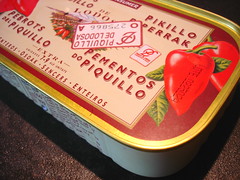
had made it home safe and sound, but somehow the recipe had gotten misplaced, so I'd never used them. I'd really been craving those wonderful stuffed peppers recently, so I finally gave up hope of finding the recipe in some overlooked corner of our apartment, bit the bullet, and admitted the loss to Esti, and I asked her to send me her family recipe once again. I still haven't received the Capetillo family recipe for Pimiento de Piquillo Rellenos de Carne--Esti's still in the thick of schoolwork--but when I opened up The New Spanish Table I was thrilled to see that Von Bremzen's book had a version. And that was just the beginning.
It's safe to say The New Spanish Table is a page-turner, both seductive and informative, and what began as casual leafing soon turned into intent reading. The next thing I knew a couple of hours had been lost to Iberian reverie (if you thought Bohemian rhapsody was fun...). Von Bremzen's book is the comprehensive reassessment that Spanish cuisine has deserved for quite some time now. It's loaded with all kinds of mouth-watering recipes, but, as its title suggests, it's also a very good survey of the state of Spanish cuisine, of how it's breaking new ground while steadfastly holding onto tradition, exemplifying the dynamism of the new Europe while simultaneously taking the care to preserve and protect its heritage and its regional specificities. I can't say I'm crazy about the style of the book, which reminds me too much of a Spanish language textbook with its layout, its "festive" color scheme, and its uses of infoboxes, but it sure makes for a good read and it makes you want to hop a plane to Madrid, Barcelona, Vitoria-Gasteiz*, or any one of a number of other Spanish cities, immediately.
In the middle of reading The New Spanish Table the phone rang. I put my book down, picked up the phone, and received an invitation to go to Tapeo for the first time. Absolutely perfect timing, a bit magical even. I'd been particularly taken by The New Spanish Table's extensive section on tapas, and if Von Bremzen's book has been something of an international hit on the cookbook scene over the last year, Tapeo has definitely been the hottest Spanish restaurant--tapas or otherwise--to open up on the local restaurant scene for years. So hot, in fact, that it's actually changed the culinary landscape of Montreal, introducing a lot of people to the sorely overlooked Villeray district. Michelle had been to Tapeo for lunch a few weeks earlier, but I'd yet to have the pleasure. I was already keen to give Tapeo a close look, The New Spanish Table had me absolutely raring to go.
So we sat at the bar on what I can only guess was a typically busy Friday night. Tapeo's small dining room, its tiny open-concept kitchen, and the excitement generated by its assortment of fresh, seasonally inspired tapas make for an electrifying experience. During her recent appearance at the Blue Metropolis festival, Ruth Reichl answered the mandatory "What are your favorite Montreal restaurants?" question (as if the March issue of Gourmet hadn't revealed enough) by placing Tapeo at the top of a very short list. Among other reasons, Reichl mentioned her passion for Mediterranean flavors and cuisines, her particular attraction to the Mediterranean style of dining. The ambience at Tapeo is absolutely infectious and as soon as the wine gets poured and those tapas start arriving things get taken to the next level. You see, not only does Tapeo have the ideal atmosphere, but their tapas go far beyond anything I've tasted anywhere else in this city. Montreal is not a bad city when it comes to tapas--both traditional and new-fangled--but dishes like seared scallops wrapped in lard fumé with quince marmalade and Xérès vinegar, gambas with a spicy, complex romanesco (romesco?) sauce, sauteed fiddleheads with garlic, and baked tilapia with rapini and almonds, not to mention the best tortilla I’ve ever had the pleasure of tasting, make for an unparalleled experience. My only gripe was that Tapeo had me wanting to take my cuadrilla and turn the night into a tapas odyssey, stumbling into one neighborhood tapas bar after another seeking out the house specialty at each stop--in other words, Tapeo almost had me convinced I was in Spain, immersed in a true tapas bar culture. If only...
Well, as good as some of the tapas in this town may be, we don't live "in a true tapas bar culture" here (I mean, whoever heard of making reservations at a true, rough-and-tumble tapas joint?), but at least we could try and contribute to the overall tapas culture, right? The only thing to do was to take matters into our own hands. So we organized a little tapas-themed soirée for the following Sunday evening. Michelle and I were in the mood to have people over, we had Spanish food on the brain (obviously), and we were just dying to give our latest acquisition a true test--it was a natural. We did some reading, we debated and discussed logistics, and then we devised our menu: olives, jamón Serrano, marinated carrots, garlicky sauteed rapini, garbanzos con chorizo, asparagus with Romesco sauce, Pimiento de Piquillo Rellenos de Carne, lots of bread to sop up all those lovely sauces, a baby arugula salad to cleanse the palate, and last, but certainly not least, a Tarta de Narajas Valenciana.
Sevillian Marinated Carrots (Zanahorias Aliñadas)
1 lb carrots, trimmed and peeled
4 garlic cloves, peeled and chopped
2 tsp cumin seeds
2 tsp dried oregano
1 pinch crushed red pepper flakes
1 tbsp finely chopped flat-leaf parsley
1 tsp coarse salt
1/2 cup plus 1 tsp extra-virgin olive oil (the more fragrant the better)
1/2 cup fresh lemon juice
1 1/2 tbsp best-quality red wine vinegar
Place the carrots in a large pot of boiling salted water and cook until just tender (they should still have a bit of crispness to them), 8-10 minutes. Drain the carrots and let cool just enough to handle, then cut them into 1/4-inch rounds.
While the carrots are cooking, place the garlic, cumin, oregano, red pepper flakes, 1 tablespoon parsley, salt, and 1 teaspoon olive oil in a mortar and, using a pestle, mash them into a medium-fine paste. Whisk the lemon juice into the garlic paste.
Place the carrots in a glass bowl while they are still warm and pour the garlic paste over them. Add the vinegar and the remaining 1/2 cup olive oil and toss to mix. Cover the bowl with plastic wrap and let marinate for at least 6 hours or refrigerate overnight. The carrots can be refrigerated for at least a week. Let the carrots come to room temperature before serving, place in a serving bowl, and garnish with some more parsley.
This recipe makes a light tapa for 8-10.
Pimiento de Piquillo Rellenos de Carne
Peppers:
4 tbsp light olive oil, plus more for frying the peppers
1 medium onion, finely chopped
2 garlic cloves, minced
12 oz ground veal
1 medium tomato, cut in half and grated on a box grater, skin discarded
coarse salt and freshly ground black pepper
2 tbsp all-purpose flour, plus more for flouring the peppers
2/3 cup whole milk
2 eggs, beaten
16-18 whole Piquillo peppers (from a can or a jar), drained**
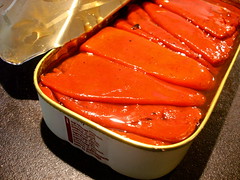
Sauce:
2 tbsp light olive oil
1/2 medium white onion, chopped
3 garlic cloves, minced
3 Piquillo peppers (from a can or a jar), drained and chopped
1 large tomato, cut in half and grated on a box grater, skin discarded
2 tsp sweet paprika
1 pinch hot paprika or cayenne
2/3 cup dry white wine
1/3 cup chicken stock or broth or water, or more if needed
3 tbsp heavy whipping cream
1 tsp best-quality red wine vinegar, or more to taste
1 small pinch of sugar
coarse salt and freshly ground black pepper
finely minced flat-leaf parsley or chives, for garnish
Heat 2 tablespoons of the olive oil in a large skillet over medium-low heat. Add the onion and garlic and cook until completely softened but not browned, about 7 minutes. Add the veal, increase the heat to medium-high, and cook, mashing and breaking the meat up with a fork, until the veal is no longer pink, about 5 minutes. Add the tomato and cook, stirring, until the tomato is thickened and the pan juices are reduced, 5-7 minutes. Season the veal mixture with salt and black pepper to taste and set aside.
Heat the remaining 2 tablespoons olive oil in a medium-size saucepan over medium-low heat. Add the 2 tablespoons flour and stir for about 30 seconds to blend. Slowly pour in the milk, whisking constantly. Increase the heat to medium-high and cook, stirring, until the béchamel sauce thickens, 3-5 minutes. Season the sauce with salt and pepper to taste, then stir it into the veal mixture until thoroughly combined. Set the filling aside until cool enough to handle.
Stuff the Piquillo peppers with the veal mixture, taking great care not to spit the sides. If you use true Piquillo peppers this will be fairly easy because they stuff well; if you substitute another kind of pimiento you may find this harder to accomplish. They peppers should be quite full, but the filling should not be spilling out. Arrange the stuffed peppers on a plate, cover them loosely with plastic wrap, and refrigerate until the filling becomes firm, at least 2 hours or up to 24.
Spread flour on a large plate, place the eggs in a shallow bowl, and line a baking sheet with paper towels. Pour the olive oil to a depth of 1/2 inch in a large skillet and heat it over medium-high heat until a little beaten egg sizzles on contact with the oil. Roll a few stuffed peppers in the flour, shaking off the excess, then dip them in the egg, again shaking off the excess. Add the battered peppers to the hot oil and cook until golden, about 2 minutes per side. Using a slotted spoon, transfer the fried peppers to the paper towels to drain. Repeat with the remaining stuffed peppers, adjusting the heat so that the oil doesn't burn. The peppers can be prepared a day ahead up to this point and refrigerated, if you like. Just keep them covered in the refrigerator.
Heat the olive oil in a medium-sized skillet over medium-low heat. Add the onion and garlic and cook until softened but not browned, about 5 minutes. Add the chopped Piquillo peppers and the tomato and cook, stirring, until the tomato is thickened and reduced, about 7 minutes, reducing the heat if necessary. Add the sweet and hot paprikas, stir for a few seconds, then add the wine and the chicken stock. Cook the sauce to reduce it slightly, 3-5 minutes. Add the cream and cook until heated through, about 1 minute. Let the sauce cool for a few minutes, then puree it in a blender until smooth. Scrape the sauce into a bowl, stir in the vinegar to taste and the sugar, and season the sauce with salt and pepper to taste. If the sauce seems too thick, dilute with a little stock or water.
Preheat the oven to 425˚F.
Spread half the tomato sauce in a baking dish that can hold the peppers in one snug layer. Arrange the peppers on top and spread the remaining sauce over them. Bake the peppers and sauce until they are very hot, about 15 minutes. Remove from the oven and let cool for about 5 minutes. Serve, garnished with parsley or chives.
Serves 8 as a tapa, 4-6 as a light main course.
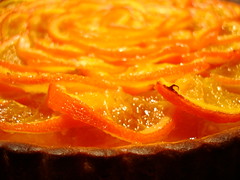
Valencian Orange Tart (Tarta de Naranjas Valenciana)
4 medium, thin-skinned California oranges, scrubbed well
2 1/2 cups fresh orange juice
1 cup sugar, plus more for caramelizing the tart
1 tbsp grated orange zest
2 tsp orange flower water (you can find this at specialty food stores, especially Middle Eastern ones)
1 cup best-quality orange marmalade (fortunately, we tend to have a lot of this in stock)
prebaked tart pastry (recipe follows)
Cut off and discard a thick slice from each end of the oranges. Using a sharp knife, cut the oranges into 1/8-inch-thick slices. Place the orange juice, sugar, grated orange zest, and orange flower water in a wide pot and bring to a simmer over medium-high heat, stirring until the sugar dissolves. Add the orange slices; if they are not submerged in liquid, add a little water. Reduce the heat to low and let the oranges simmer, partially covered, for 15 minutes. Let the oranges slices cool in the cooking liquid, then drain them and gently pat them dry with paper towels. Cut the orange slices in half.
Position a rack in the center of the oven and preheat the oven to 375˚F.
Spread the marmalade evenly in the bottom of the tart shell and arrange the halved orange slices on top in concentric circles, overlapping slightly. Bake it on the center rack until the oranges are very soft and lightly browned, 30 minutes.
Preheat the broiler. When the tart is just cool enough to handle, wrap aluminum foil around the edge of the crust so that it doesn't burn when the tart is caramelized. Sprinkle sugar in a think, even layer over the tart and broil until the sugar is caramelized, 4-7 minutes, depending on the heat of the broiler, being very, very careful not to let the tart burn (you can achieve the same effect with a kitchen blowtorch, if you're lucky enough to have one). Let the tart cool to room temperature before serving.
Prebaked Tart Pastry
1 1/2 cups all-purpose flour
2/3 cup confectioners' sugar
1 medium-size pinch of salt
10 tbsp (1/4 sticks) unsalted butter, chilled and cut into small pieces
1 large egg yolk beaten with 2 tbsp chilled heavy whipping cream
1 tbsp ice water, if needed
special equipment:
food processor
9-inch tart pan with removable bottom
pie weights (or dried beans)
Place the flour, the sugar, and salt in a food processor and pulse 5 or 6 times, just to combine. Add the butter and pulse until the mixture resembles coarse meal.
Transfer the flour mixture to a bowl and, using two forks, stir in the egg yolk mixture until it is evenly distributed. Pinch a piece of dough between your fingers. If it doesn't hold together, stir in the ice water. Gather the dough into a ball. Lightly flour a work surface, then flatten the ball into a disk, wrap it in plastic, and refrigerate for at least 2 hours. (The pastry can be prepared up to 48 hours in advance.)
Place the disk of dough between two pieces of lightly floured parchment paper and roll it out to an 11-inch circle. Transfer the dough to a 9-inch tart pan with a removable bottom, press into the side of the pan, and trim the overhang. Freeze, covered with aluminum flour, for 20 minutes.
While the pastry is in the freezer, position a rack in the center of the oven and preheat the oven to 400˚F.
Without removing the aluminum foil, fill the tart pan with pie weights or dried beans, then bake it for 25 minutes. Remove the pie weights and the foil and continue baking until the pastry is light golden and baked through, 8-10 minutes longer. Let cool completely in the pan on a rack before filling.
All recipes from Anya Von Bremzen's The New Spanish Table (Workman Publishing, 2005)
The verdict? All three dishes were a hit, and so was the dinner party. The carrots are a perfect appetizer and I can imagine having them with all kinds of meals, not just Spanish ones. They reminded us a lot of a phenomenal carrot pickle we had in a Moroccan restaurant in Paris a couple of years back. Suffice to say, we were ecstatic to rediscover those flavors. The Piquillo peppers were a bit involved, but very much worth it. I only had about 10 peppers, but we were only feeding 7, so I just made what I had and saved the remaining veal mixture for some exceptional stuffed bell peppers later in the week. This recipe didn't quite live up to the stuffed Piquillo peppers Esti made back in Germany, but they were a close second. You can be sure that when I receive Esti's recipe I'll be running a comparison--one you can expect to hear about. And finally, it's rare that you find anything other than flan served for dessert in even your finer Spanish restaurants. One of the things that impressed me about Von Bremzen's book--and which got Michelle very excited indeed--was the attention she paid to Spanish sweets. She devotes nearly 60 pages to Spanish desserts of all kinds--including cakes, tarts, custards, ice creams,
granitas, and candies--and her selection is sure to utterly change your notion of Spanish dessert-making. The Valencian Orange Tart made for a perfect closer: tart, sweet, and light on the palate.
It's safe to say that Spanish cuisine is very much at the center of the international culinary scene these days. Like so many other cultural arenas, this rebirth started in the years that followed the end of the Franco regime--the rediscovery of cuisine was part of the new freedom, an important part of Spain's modern turn. It began with
nouvelle cuisine pioneers like Juan Mari Arzak in the late-1970s and it has continued through to the emergence of Ferran Adrià Superstar and molecular gastronomy in the late-1990s, but as Von Bremzen makes emphatically clear, Spain's culinary boom is made up of both "high" and "low," avant-garde experimentation and authentic regional flavors. The reverberations from this explosion can be felt far and wide. You can feel them in a district of Montreal as far-removed from Spain as Villeray. Then again, with the help of people like Anya von Bremzen, you may just be able to feel them at home.
Tapeo, 511 Villeray E., (514) 495-1999
aj
*See Anthony Lane's recent
New Yorker article--"High and Low: Flying on the Really Cheap" (April 24, 2006)--on the mysteries of airline travel in the new Europe.
**True, certified Protected Designation of Origin Piquillo peppers are hard to find in Montreal. You can find them at Olives et Épices at Jean-Talon Market though.
